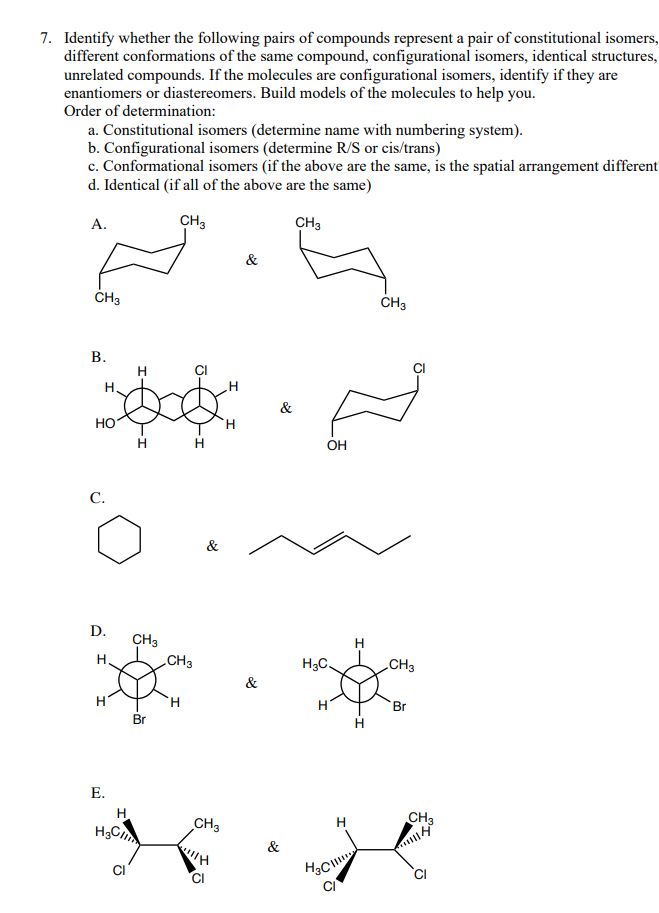7. Identify whether the following pairs of compounds represent a pair of constitutional isomers different conformations of the same compound, configurational isomers, identical structures, unrelated compounds. If the molecules are configurational isomers, identify if they are enantiomers or diastereomers. Build models of the molecules to help you. Order of determination: a. Constitutional isomers (determine name with numbering system). b. Configurational isomers (determine R/S or cis/trans) c. Conformational isomers (if the above are the same, is the spatial arrangement different d. Identical (if all of the above are the same) А. CH, CH3 & В. H. & HO H H ÓH С. &
7. Identify whether the following pairs of compounds represent a pair of constitutional isomers different conformations of the same compound, configurational isomers, identical structures, unrelated compounds. If the molecules are configurational isomers, identify if they are enantiomers or diastereomers. Build models of the molecules to help you. Order of determination: a. Constitutional isomers (determine name with numbering system). b. Configurational isomers (determine R/S or cis/trans) c. Conformational isomers (if the above are the same, is the spatial arrangement different d. Identical (if all of the above are the same) А. CH, CH3 & В. H. & HO H H ÓH С. &
Organic Chemistry: A Guided Inquiry
2nd Edition
ISBN:9780618974122
Author:Andrei Straumanis
Publisher:Andrei Straumanis
Chapter6: Alkanes & Alkenes
Section: Chapter Questions
Problem 21E
Related questions
Question
100%

Transcribed Image Text:7. Identify whether the following pairs of compounds represent a pair of constitutional isomers,
different conformations of the same compound, configurational isomers, identical structures,
unrelated compounds. If the molecules are configurational isomers, identify if they are
enantiomers or diastereomers. Build models of the molecules to help you.
Order of determination:
a. Constitutional isomers (determine name with numbering system).
b. Configurational isomers (determine R/S or cis/trans)
c. Conformational isomers (if the above are the same, is the spatial arrangement different
d. Identical (if all of the above are the same)
А.
CH3
CH3
&
ČH3
CH3
В.
H.
&
НО
H.
OH
С.
&
D.
CH3
CH3
H.
H.
H3C.
CH3
&
Br
Br
H
E.
H
H3C
CH3
CH3
&
CI
Expert Solution
This question has been solved!
Explore an expertly crafted, step-by-step solution for a thorough understanding of key concepts.
This is a popular solution!
Trending now
This is a popular solution!
Step by step
Solved in 3 steps

Knowledge Booster
Learn more about
Need a deep-dive on the concept behind this application? Look no further. Learn more about this topic, chemistry and related others by exploring similar questions and additional content below.Recommended textbooks for you

Organic Chemistry: A Guided Inquiry
Chemistry
ISBN:
9780618974122
Author:
Andrei Straumanis
Publisher:
Cengage Learning


Organic Chemistry: A Guided Inquiry
Chemistry
ISBN:
9780618974122
Author:
Andrei Straumanis
Publisher:
Cengage Learning
